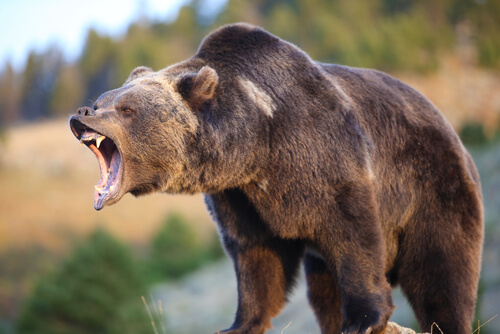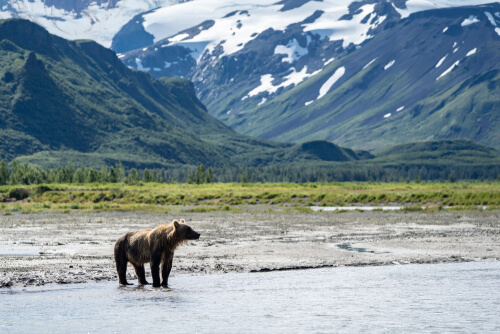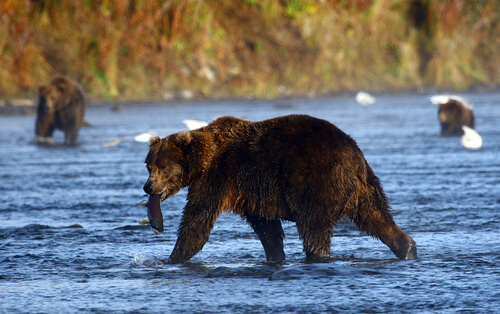
| Kingdom | Animalia |
| Phylum | Chordata |
| Class | Mammalia |
| Order | Carnivora |
| Family | Ursidae |
| Genus | Ursus |
| Species | Ursus arctos |
| Subspecies | Ursus arctos middendorffi |
| Niche | Apex Predator, Omnivorous Opportunist |
| Height | 5 ft (1.5 m) at withers |
| Weight | 660-1 320 lbs (300-600 kg) |
| Lifespan | 20-25 years |
| Social Structure | Mostly solitary outside breeding season |
| Conservation Status | Unclear |
| Preferred Habitat | Coastal mountains |
| Average Litter Size | 2-3 cubs |
| Main Prey Species and Food Items | Salmon, crustaceans, mollusks, mammals, berries, plants |
| Predators | Male Kodiak bear, humans |
The Basics
The Kodiak bear is a subspecies of grizzly bear native to the Kodiak Archipelago in southwestern Alaska. Despite its massive size and reputation as a fierce predator, it is generally an opportunist and will eat a large variety of plant and animal species. Also known as the Kodiak brown bear or Alaskan brown bear, it is the largest subspecies of grizzly and among the largest bears on the planet, second only to the polar bear.

The Kodiak bear (Ursus arctos middendorffi) appears very similar to other brown bears, also called grizzly bears (Ursus arctos). However, it is significantly larger, weighing up to 1 320 lb (600 kg) and standing about 5.1 ft (1.5 m) tall at its shoulders when standing on all fours. When standing on its hind legs the Kodiak bear is as tall as 10 ft (3 m). Females, called sows, are typically about 20-30% smaller than males, which are referred to as boars. In contrast, most mainland grizzlies weigh approximately 250-790 lb (115-360 kg), about 40% lighter than Kodiak grizzlies.
Distribution and Habitat
This population of isolated grizzly bears occurs in a small part of the world. Specifically, they are found throughout the Kodiak Archipelago, a remote series of islands in southwestern Alaska. The largest island in the archipelago is known as Kodiak Island. It is the second-largest island in the USA and is considered the heart of the Kodiak bear’s range.

Within this range, Kodiak bears don’t aggressively defend territory the way many other grizzly populations do. Also, their home ranges – at about 50 sq. mi (130 km2) for sows and about 97 sq. mi (250 km2) for boars – are among the smallest of all brown bears. This may be a result of the uniquely productive coastal area these bears occupy. With food being abundant, bears live in relatively high density and their home ranges overlap significantly. This lack of food scarcity, conflict arising from this living arrangement is relatively rare. In fact, during the salmon run, it is not uncommon to find dozes of bears together in a small area feeding on fish.
Diet
Despite the significant difference in size, Kodiak bears’ diets don’t differ significantly from other brown bears. Within their range, they are opportunistic feeders, and, for the first part of spring, will often subsist on animals such as dead deer and other animals. They will also feed on emerging vegetation and the first berries of the season during this time. Most bears simply find what they can, such as crustaceans and shellfish in the intertidal area, until the fall arrives. Once the salmon begin to run in the streams again, coastal bears will have a bonanza to feast on. They will feed on mainly salmon during this time while building up their fat reserves for winter.
Typical hibernation for the Kodiak bear occurs between late October and late June, with pregnant sows being among the first to enter and last to leave their dens most years. Males typically emerge in early April in search of food and a mate for the coming breeding season.
Reproduction
Young bears reach sexual maturity at about 5 years of age and are adult-sized by about 6. However, most sows are about 9 years old by the time they raise their first litter of cubs.
Mating season occurs in early summer, typically in May and June. Kodiak bears are described as ‘serially monogamous’, meaning they will only pair up with one other bear at a time but will have multiple partners throughout their lives. During the mating season, a breeding pair will spend several days or weeks together, culminating in copulation.
Cubs are typically born about 8 months later, in January or February. This occurs inside the den during the sow’s winter hibernation. The average litter size is about 2-3 cubs. At birth, they typically weigh about 15-20 lbs (6.8-9.1 kg) and rely on their mother for nursing. The bears will emerge from their den that spring and begin foraging while the mother protects them fiercely. Young bears will remain with their mothers for about 3 years before setting out on their own. Females will often take up an adjacent or nearby home range to their mothers while typically wander further afield in search of their new home range.
Most females will give birth once every four years, with decreasing productivity after the age of about 20. Most individuals live a few years older than this, with the oldest known wild boar dying naturally at the age of 27.
Conservation Status
The grizzly bear, including the Kodiak subspecies, is listed as “Least Concern” by the IUCN. However, this lack of distinction between subspecies means that the extent to which the Kodiak bear specifically is threatened remains uncertain. Within its range, there is estimated to be about 3 500 bears or about 700 bears per 1000 square miles, with populations apparently on the rise.
Kodiak bears have few natural predators, although many young bears are killed by other members of their species before they reach independent age or shortly after. Humans have hunted Kodiaks for millennia, although not in any intensive way until recent decades.
Fun Facts about the Kodiak Bear!
One of the largest carnivores in the world, the Kodiak grizzly has captured the imagination humankind for millennia. First Nations cultures occasionally hunted the bears and have long associated it with their spirituality and culture.
The Largest Land Carnivore
The Kodiak bear rivals the massive polar bear in size, particularly in sheer mass. However, the polar bear’s water-and-ice loving ways mean that it is labeled as a marine mammal rather than a terrestrial mammal. Therefore, that makes the Kodiak bear the largest terrestrial (land-living) carnivore in the world.
Kodiak Bear Encounters
Due largely to their remote and rugged coastal habitat, encounters between humans and Kodiak bears have been rare historically. However, as is the case around the world, human development continues to encroach on the natural habitats of many species. The Kodiak bear is no exception to this and, despite its relative isolation, recent increases in the human population within its range have led to a predictable increase in encounters as well.

However, most of these encounters are driven by humans. Hunters frequently seek the rare species to harvest its meat or simply claim it as a trophy. Occasionally, attacks on man instigated by Kodiak bear also occur, usually while they defend their young or a food source such as a fresh ‘kill’.
East or West
All North American grizzly bears have been merged into a single species, Ursus arctos, by taxonomists. However, genetic analyses of Kodiaks revealed them to be related to both the brown bears of Alaska as well as those of the Kamchatka Peninsula in far eastern Russia. Despite these relations, the analysis also suggests that Kodiaks have been genetically isolated for at least 10 000-12 000 years since the last ice age when the current range of Kodiak bears was less geographically isolated than it is now.
